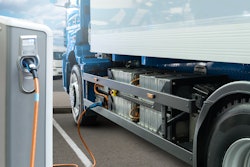
Implementing alternative powertrains is a learning curve for fleets and dealers alike. In the case of battery electric and hydrogen fuel cell technology, dealer associates are required to receive OEM training on the equipment before selling it.
Both sides believe that’s a good idea.
“We want to make sure our dealers are prepared to support customers and to do that they need training,” says Jared Ruiz, EV leader and vice president at Volvo Trucks North America. “This equipment is much different than what our dealers — and customers — are accustomed to. It is important that every employee at a dealership goes through safety training to understand the product and how to handle it.”
“Our people are experts on traditional [internal combustion] powertrains. They know how they work, how to sell them, service them and how to be safe around them,” adds Alexander Voets, general manager, EV, at Velocity Vehicle Group. “That’s not the case with EVs.
“For us to support this technology, we have to be experts like we are with diesel.”
Bringing dealers up to speed
OEMs created curricula for dealers tailored to that goal. With distinct training for each department within a dealership — technician and sales courses being the most expansive — manufacturers have training programs designed to educate anyone who may come in contact with an EV or alternative powertrain on how to be safe and smart around the unit.
“Our goal is to make sure every touch point understands what the process is around this equipment,” says Ruiz.
For internal departments like accounting, human resources and others, most training is safety focused. OEMs says employees in these departments may not come directly in contact with this equipment but they should be aware of how the equipment is different than diesel internal combustion engines.
“Training and education are so important with this technology because it’s new to everyone,” says Michael Lynch, director, Zero Emissions, Navistar. “More than anything we want everybody to be safe.”
‘Get everyone home safe’
In no department is safety more important than the service shop. Technician training courses on EVs from manufacturers build on the general safety practices taught to all dealer associates. Courses exist for tasks as simple as powering down equipment to challenging work like battery extraction, systemwide electrical troubleshooting, evacuating a vehicle during a thermal event and more.
Because of the extremely high voltages found in EVs — “50 volts can stop a human heart” — all North American OEMs require dealer technicians to be certified to perform EV work.
Lynch says Navistar requires any shop that will perform EV service have at least two certified technicians. Other OEMs have similar rules.
“We’re kind of hitting a new industrial revolution, but instead of ICE it’s with batteries,” says Navistar’s Adam Krey, dealer development manager, Continuous Improvement, and chair of TMC’s EV Shop Bay Planning task force. “It’s important that we’re vigilant in understanding this technology because it can be dangerous. It can kill you. We can’t take it lightly.”
Adds Ashley Rush, project manager, Aftersales Business Center at Navistar, and secretary of TMC’s Safety Aspects of EVs task force, “Our number one job is to get everyone home safe.”
(For more on technician safety, see our article “Safety in the Service Bay.”)
Creating sales consultants
Parts and truck sales professionals require more education due to their customer-facing roles. Beyond safety instruction, many OEMs are requiring salespeople receive detailed product courses so they can intelligently speak to alternative powertrain and EV technologies when interacting with customers.
Adoption of these new technologies will not occur if salespeople are unable to sell their advantages.
[RELATED: Performing an alternative power market analysis]
“We want our customers to be as informed as possible about this technology, and for us to do that we have to train our dealers. We want them to be able to consult with their customers and show them where these vehicles make sense,” says Lynch.
Sales training also should include instruction regarding purchase incentives. Many manufacturers and states have departments dedicated to cataloging incentive programs. Dealers can leverage these assets to help secure funding for customers.
(For more on sales training, see our article “How to effectively sell alternative power.”)
Be aware of training obstacles
The importance of employee buy-in also shouldn’t be overlooked when it comes to new technology, says CALSTART’s Clare Bachman, fleet technical assistance project manager.
Salespeople without clear directives to include alternative powertrains or EVs in a new truck sales presentation are unlikely to do so. “They have much more incentive to continue selling the diesel product they’ve always known,” Bachman says, “rather than take a risk promoting a new technology to a customer.”
She adds, “dealer non-responsiveness is real.”
But in California, where zero-emission vehicle (ZEV) sales requirements will soon take effect, that tactic could get dealers in hot water with regulators. Bachman says if salespeople understand applications best suited to commercial ZEVs and their state’s incentive options, they can selectively pitch the technology to customers most likely to benefit from it, helping both sides.
“If a dealer knows the math [on the technology], they will know which of their customers could be a good match,” she says.
Keep up with our special report on trucking's transition to cleaner trucks:
Part I: This isn't trucking's first fueling and propulsion revolution
Part II: Why are we doing this?
Part III: What constitutes as ‘alternative power’?
Part IV: What will drive — or inhibit — alternative power adoption?
Part V: Performing an alternative power market analysis
Part VI: What it takes to install charging infrastructure
Part VIII: The challenges of building your best EV service bay
Part IX: Making the case: How to effectively sell alternative power
Part X: Safety in the Service Bay
Part XI: How electric trucks may transform dealer revenue streams










